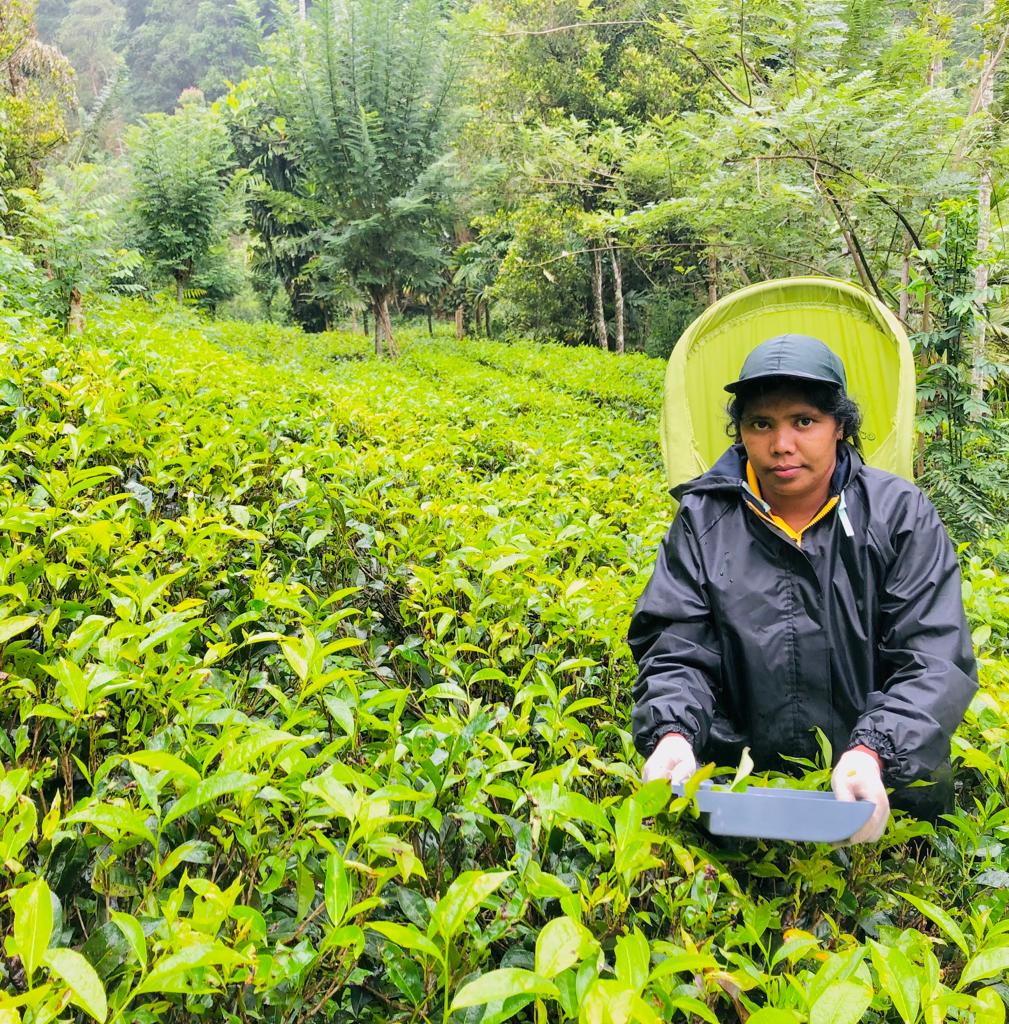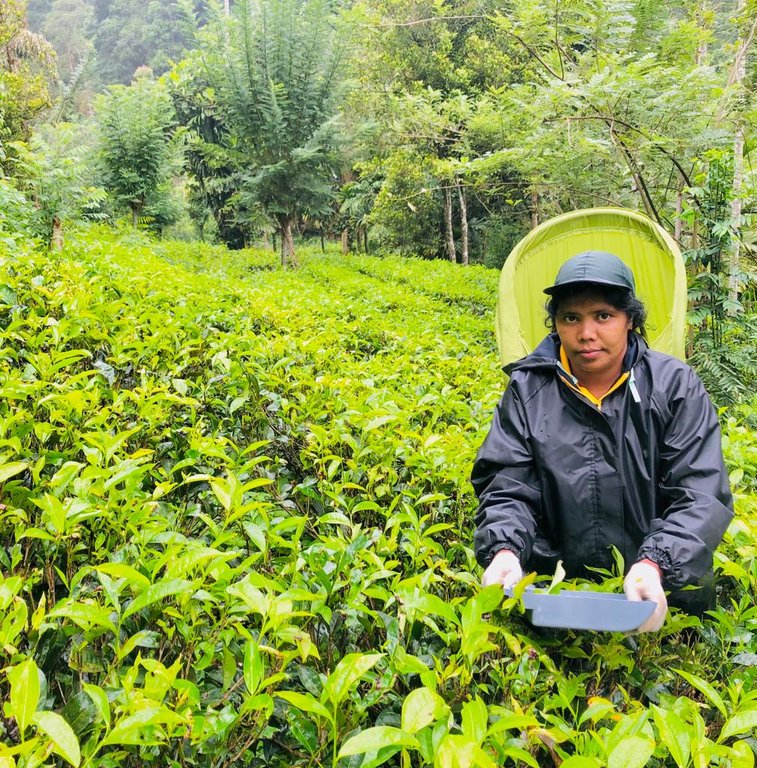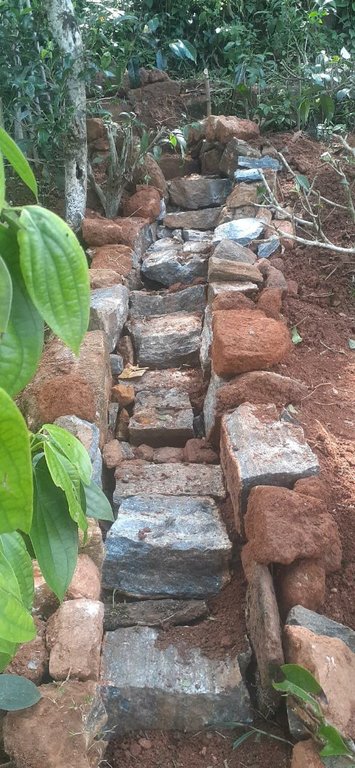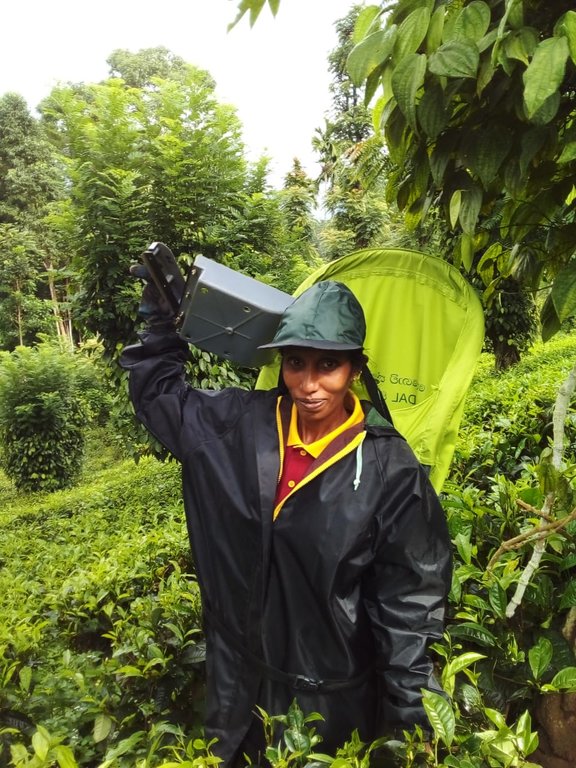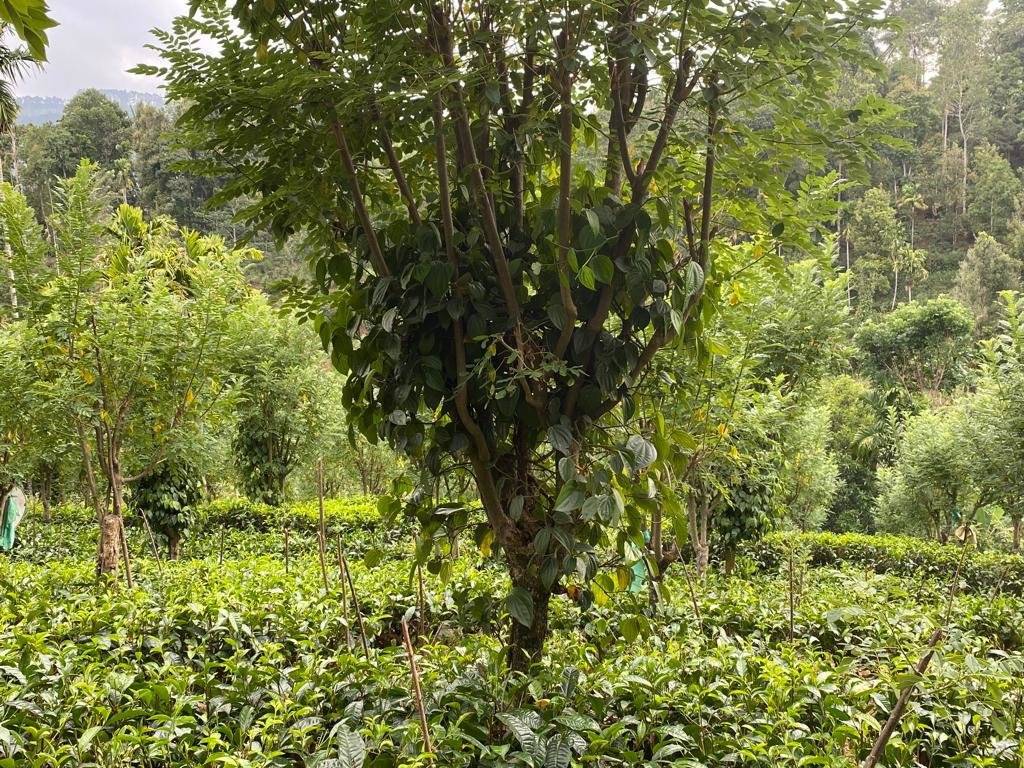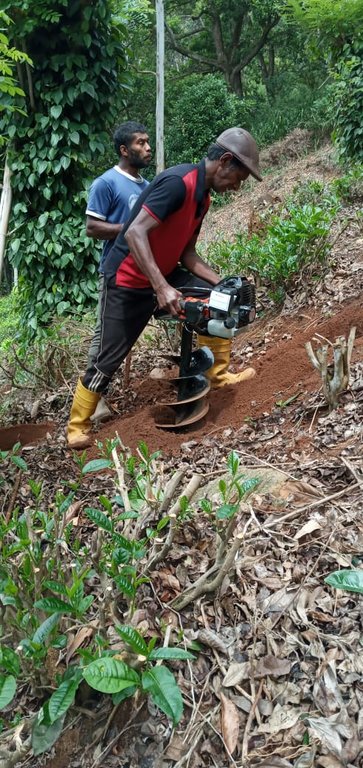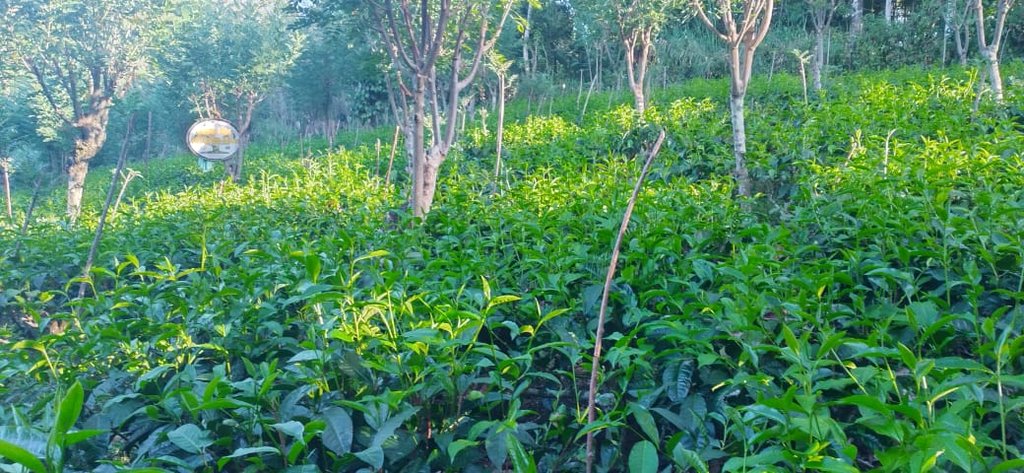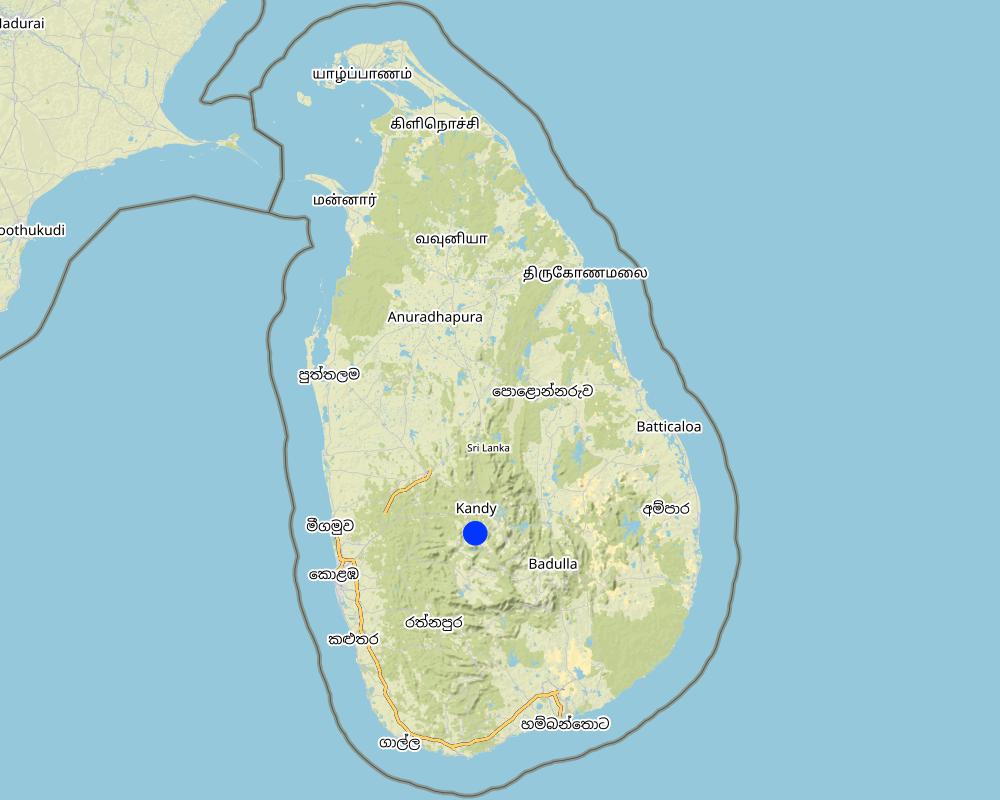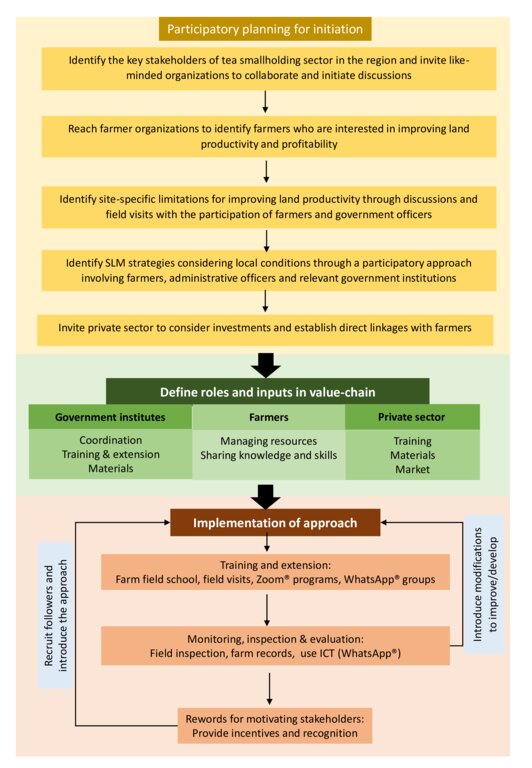Inter-sectoral collaboration for sustainable land management in tea smallholdings [斯里兰卡]
- 创建:
- 更新:
- 编制者: Head Soil Science
- 编辑者: –
- 审查者: William Critchley, Rima Mekdaschi Studer
Inter-sectoral collaboration for sustainable land management in tea smallholdings
approaches_6182 - 斯里兰卡
查看章节
全部展开 全部收起1. 一般信息
1.2 参与方法评估和文件编制的资源人员和机构的联系方式
co-compiler:
co-compiler:
Agrarian Research and Production Assistant:
Iroshini Senevirathna
+94778278582
iroshinisenavirathna@gmail.com
Department of Agrarian Development
Agrarian Research and Production Assistant Office, "Nila Sewana", Pambadeniya
斯里兰卡
土地使用者:
Pushpa Ranjani
+94767817221
“Sithamu Ranliya” farmer's organization
Pambadeniya, Panvilathanna
斯里兰卡
有助于对方法进行记录/评估的项目名称(如相关)
Rehabilitation of Degraded Agricultural Lands in Kandy, Badulla and Nuwara Eliya Districts in the Central Highlands of Sri Lanka有助于对方法进行记录/评估的机构名称(如相关)
Faculty of Agriculture, University of Peradeniya, Sri Lanka (AGRI.PDN) - 斯里兰卡1.3 关于使用通过WOCAT记录的数据的条件
(现场)数据是什么时候汇编的?:
25/02/2022
编制者和关键资源人员接受有关使用通过WOCAT记录数据的条件。:
是
2. SLM方法的描述
2.1 该方法的简要说明
Participatory land restoration with the collective efforts of different stakeholders can assure sustainable use of land-resources. This approach promoted sustainable land management technologies such as agroforestry, soil conservation, and soil fertility enhancement practices through inter-sectoral collaboration, including the use of digital tools and Farmer Field Schools (FFS) to provide training and resources, disseminate knowledge, improve market-orientation of farmers, and monitor and evaluate the progress of activities for rehabilitating and increasing the productivity of degraded tea smallholdings in the Central Highlands of Sri Lanka.
2.2 该方法的详细说明
该方法的详细说明:
Due to unsustainable land management practices the monthly average green-leaf yield of tea smallholdings in Maligamale watershed in the Central Highlands of Sri Lanka is as low as 1000 kg/hectare, whereas the potential is 2400 kg/hectare. Soil erosion, soil fertility decline, low plant density, and poor shade management are among the main reasons for low productivity. This causes reduced household incomes and farmers’ ability to invest in sustainable land management (SLM) practices. Inefficiencies in top-down extension methodology, lack of awareness and training on tea cultivation techniques, poor business practices, lack of access to services and poor perceptions about SLM have reduced profit margins of tea smallholdings. Hence, the aim/ objectives of the approach are to increase the land productivity in tea smallholdings and increase farmer’s incomes and gain environmental benefits through proper implementation of SLM practices. To address this, the Rehabilitation of Degraded Agricultural Land Project (RDALP) introduced a participatory approach together with Tea Smallholdings Development Authority (TSHDA), Department of Agrarian Development and other relevant government institutions, the private sector and farming community. The approach considered methods for strengthening linkages between stakeholder groups, providing training and resources for SLM practices, enhancing market orientation, using ICT for knowledge sharing, monitoring and evaluation, improving perceptions of farming community on agriculture and enhancing food-security of the households.
Firstly, tea smallholders who volunteered to learn about SLM were linked with the experts to collectively develop a participatory land restoration proposal. Site specific limitations for productivity improvement, recommendations, roles of different stakeholders, and training and material needs were identified in the proposal. The existing institutional setup was used for coordination of activities. The experts from government institutes provided training on SLM through farmer field schools, field demonstrations and ICT tools. More specifically, farmers were educated on soil conservation and soil fertility management practices: these included producing organic fertilizers using locally available resources, building live fences with green-manure crops and edible crops, intercropping using export agriculture crops, in-filling, selective weeding, developing and maintaining nurseries, using machinery for cutting pits and harvesting, using safety measures during field operations, and shade tree management. In addition, farmers have been encouraged to share good-practices, keep records and practice soil test-based decision making for nutrient management. Farmers and officers effectively used WhatsApp®, Zoom® and Facebook® for knowledge sharing and for monitoring and evaluating progress. Dissemination of knowledge using ICT and performance-based rewarding helped to recruit more farmers as followers. The TSHDA supported with extension service and regular monitoring of progress. With the support of government institutes, farmers were linked with private sector companies to promote market orientation. Export agriculture crops such as peppers, vanilla, areca nut and cloves were successfully incorporated into tea smallholding landscape, allowing farmers to earn an extra income. The partners from the private sector provided planting materials and extension services to transfer necessary knowledge and skills to the farmers. Machinery was provided to farmer organizations for the members to share.
Improving profitability of farming, improving hygiene and safety of farmers, and reducing time spent on agronomic practices have uplifted the living-status of famers and increased their willingness to invest in SLM. These characters could attract youth to the sector.
2.3 该方法的照片
2.4 该方法的视频
注释、简短说明:
https://www.youtube.com/watch?v=SU3--fHKY1k
Application of ICT for knowledge dissemination and agricultural extension service
日期:
20/07/2021
位置:
Pambadeniya, Panvilathanna
2.5 采用该方法的国家/地区/地点
国家:
斯里兰卡
区域/州/省:
Kandy District- Central Province
有关地点的进一步说明:
Pambadeniya village
注释:
The region is in the Maligamale watershed in the Central Highlands of Sri Lanka.
Map
×2.6 该方法的开始和终止日期
注明开始年份:
2017
注释:
Approach is still carrying out by land user
2.7 方法的类型
- 基于项目/方案
2.8 该方法的主要目的/目标
The aims/ objectives of the approach are to increase the land productivity in tea smallholdings and increase farmers' income and environmental benefits through proper implementation of SLM practices.
2.9 推动或妨碍实施本办法所适用的技术的条件
社会/文化/宗教规范和价值观
- 启动
Increased livelihood requirements and access to education, market and health services
- 阻碍
Migration of youth and males to cities
财务资源和服务的可用性/可得性
- 启动
Providing funds/ subsidies has increased the access to financial resources (subsidy schemes of TSHDA, Loan facilities of tea factories)
- 阻碍
Access of farmers to resources is limited by their financial situation as well as geographic location.
机构设置
- 启动
An institutional set-up for facilitating the approach already exists and all technical support is providing by institutes
- 阻碍
Mandate of some institutions are not clearly defined. Decision making is very often a top-down approach
参与者的的协作/协调
- 启动
Institutes have some level of collaboration
- 阻碍
There is lack of motivation to initiate collaboration and the level of collaboration depends on the commitments of the officers. Institutional mechanisms do not encourage the collaborations
法律框架(土地使用权、土地和水使用权)
- 启动
Some land users own their land
- 阻碍
Some lands used by farmers are owned by the state and there are issues on land rights. Water availability is problematic to farmers as the crop is maintained as a rainfed crop. In the region, drinking water is supplied in ten days interval during dry-months
政策
- 启动
National soil conservation act
- 阻碍
Implementation of policies to action is very low
土地治理(决策、实施和执行)
- 启动
Farmers participated in the decision-making process related to land management. Land is maintained based on the advice given under the approach. Most of the technologies introduced were not gender biased and therefore, involvement of women in management practices increased
- 阻碍
Dependence on males is high for agronomic practices in tea-cultivation
了解SLM,获得技术支持
- 启动
Farmers were guided through farmer training programs, practical sessions, farmer field schools, Zoom® meetings, sharing knowledge through WhatsApp® groups and Facebook.
- 阻碍
Shortage of tea extension officers
市场(购买投入,销售产品)和价格
- 启动
Private companies come to fields to purchase products and they provide extension support and material inputs to some extent to the farmers who have established links with them
- 阻碍
Market orientation of farmers is low and their ability to negotiate prices is poor due to various factors
工作量、人力资源可用性
- 启动
Labour resources are available. Introduction of machinery created shared responsibilities and reduced labour demand while creating an income source for the farmer organizations. Decent working environment with safety kits and machineries will encourage the labour force to remain in the sector
- 阻碍
Labour force continuously moving away from the industry
3. 相关利益相关者的参与和角色
3.1 该方法涉及的利益相关者及其职责
- 当地土地使用者/当地社区
Men and women farmers are involved in tea cultivation
They involved in practicing SLM technologies as the technologies were not gender biased. But the operation of mechanical weeder and auger for infilling are mainly done by male farmers.
- 社区组织
Farmer organizations
Support coordination of activities with farmers
Support Farmer Field Schools
Maintain common equipment and rent for members and non-members to support SLM practices
- SLM专家/农业顾问
Tea Smallholding Development Authority, Department of Agrarian Development, Department of Export Agriculture, Department of Agriculture
Provide tea plants for infilling, promote inter-cropping and provide technical guidance to farmers
Serve as resource-persons in Farmer Field Schools and in WhatsApp® groups
- 研究人员
University of Uva Wellassa, Sri Lanka
Study the effectiveness of knowledge dissemination approach and effectiveness of some SLM technologies
- 私营部门
Several private sector companies are involved (Bio Food (Pvt) Ltd, Adamjee Lukmanjee (Pvt) Ltd)
Buying products, providing planting materials and continuing extension services to transfer necessary knowledge and skills to the farmers who are linked with them
- 地方政府
Local government institutes are involved in the process (Tea Smallholdings Development Authority (TSHDA), Department of Agrarian Development, Department of Agriculture, Department of Export Agriculture, Divisional Secretariat office- Doluwa
Capacity building, advisory services on fertilizer usage, land management, crop selection etc.
- 国家政府(规划者、决策者)
Ministry of Environment
Helps to raise awareness among private and government sector stakeholders and within communities about SLM approaches and technologies,
Project coordination and partial financial support
- 国际组织
Food and Agriculture Organization of the United Nations
Project coordination, partial financial support and capacity building
如果涉及多个利益相关者,请注明领导机构:
Tea Smallholdings Development Authority (TSHDA)
3.2 当地土地使用者/当地社区参与该方法的不同阶段
| 当地土地使用者/当地社区的参与 | 指定参与人员并描述活动 | |
|---|---|---|
| 启动/动机 | 互动 | Government agencies, representatives from farmer organizations, RDALP team. Discussions to develop participatory land use plans for a region and identify the sectors to be developed |
| 计划 | 互动 | Government agencies, representatives from farmer organizations, RDALP team Discussions, site visits and field programs to identify factors limiting land productivity and implementation of SLM practices Identify strategies to address these limitations Identify how the private sector can contribute and invite them to invest |
| 实施 | 互动 | Government agencies, leaders of farmer organizations, farmers, RDALP team, private sector companies Training and dissemination of knowledge through demonstrations, farmer training programs, farmer field schools Progress monitoring and evaluation Provide advisory services to farmers as needed Conduct performance-based rewarding to motivate the practitioners and to recruit followers |
| 监测/评估 | 互动 | TSHDA, RDALP team, farmers, private sector companies make observations in fields, guiding land users, exchange photos through whatsapp® Some private sector companies also involve in monitoring and field evaluating process (Adamjee Lukmanjee (Pvt) Ltd) |
3.3 流程图(如可用)
具体说明:
Before implementing the approach the level of productivity of tea lands that belong to the farmers who participated in the project were in class ‘C’ and below. In this scale of productivity lands were classified from A to D where A is the best and D is the worst. After implementation of the approach most of the fields upgraded to ‘A’ and ‘B’ performance levels. An interview conducted with a farmer revealed that the average green-leaf tea yield before and after participating in the approach were 1000 kg/ha/month and 2400 kg/ha/month, respectively.
作者:
Warshi S. Dandeniya
3.4 有关SLM技术选择的决策
具体说明谁有权决定选择要实施的技术:
- 所有相关参与者,作为参与式方法的一部分
明确做出决策的依据:
- 对充分记录的SLM知识进行评估(基于证据的决策)
- 研究结果
- 个人经验和意见(无记录)
4. 技术支持、能力建设和知识管理
4.1 能力建设/培训
是否为土地使用者/其他利益相关者提供培训?:
是
明确受训人员:
- 土地使用者
- 现场工作人员/顾问
如果相关,请说明性别、年龄、地位、种族等。:
Training was provided for both men and women; age between 20-70 years old
培训形式:
- 农民对农民
- 示范区域
- 公开会议
- 课程
培训形式:
- Zoom discussions, Farm Field Schools
涵盖的主题:
Soil conservation practices, intercropping in tea lands, organic fertilizer preparation (compost tea, vermi- compost), burying of pruned plant parts, infilling, documentation, improving tea buds quality and quantity, handling of machines for cutting pits and tea plucking
注释:
Farmer trainings are much important to spread easy agronomic practices and scientific knowledge to farmers
4.2 咨询服务
土地使用者有权使用咨询服务吗?:
是
指明是否提供了咨询服务:
- 在土地使用者的土地上
说明/注释:
Demonstration, advisory service was carried out through: government extension system, agricultural instructors and some private sector companies such as Adamjee Lukmanjee (Pvt) Ltd company which is giving support to enhance vanilla cultivation as an intercrop
4.3 机构强化(组织发展)
是否通过这种方法建立或加强了机构?:
- 是,适度
具体说明机构的强化或建立程度:
- 本地
具体说明支持类型:
- 能力建设/培训
- 设备
- providing safety kits and tea plants for infilling
提供进一步细节:
Organizing and conducting training programs, providing machineries for tea plucking and cutting pits, distribute safety kits among land users
4.4 监测和评估
监测和评估是该方法的一部分吗?:
是
若是,该文件是否用于监测和评估?:
否
4.5 研究
研究是该方法的一部分吗?
是
明确话题:
- 技术
5. 融资和外部物质支持
5.1 该方法中SLM组成部分的年度预算
如果不知道准确的年度预算,请给出一个范围:
- 100,000-1,000,000
5.2 为土地使用者提供财政/物质支援
土地使用者是否获得实施该技术的财政/物质支持?:
是
如果是,请具体说明支持的类型、条件和提供者:
Provide machinery for cutting pits and plucking, safety kits and tea plants for infilling as material support, provide financial support for soil testing, to add liming material for correcting soil pH for those who performed soil testing
The material and financial support was provided by RDALP team with contributions from TSHDA and private sector based on performance evaluation
5.3 对特定投入的补贴(包括劳动力)
- 设备
| 具体说明哪些投入得到了补贴 | 程度如何 | 对补贴做出具体说明 |
|---|---|---|
| 机械 | 充分融资 | Tea plucking machines, grass cutting machines and machine for cutting pits in tea lands |
| 工具 | 充分融资 | Tea buds collecting buckets |
- 农业
| 具体说明哪些投入得到了补贴 | 程度如何 | 对补贴做出具体说明 |
|---|---|---|
| Planting materials, liming materials | 充分融资 | Tea plants for infilling, liming materials to correct soil pH, soil testing service |
- 其它
| 其它(具体说明) | 程度如何 | 对补贴做出具体说明 |
|---|---|---|
| Safety kits | 充分融资 |
如果土地使用者的劳动力是一项重要的投入,那么是不是:
- 自愿
注释:
Most of the time family members are engaged with field activities and hire labour for tea plucking
5.4 信用
是否根据SLM活动的方法给予信用值?:
否
5.5 其它激励或手段
是否有其他激励措施或工具用于促进SLM技术的实施?:
是
6. 影响分析和结论性陈述
6.1 方法的影响
该方法是否有助于当地土地使用者,提高利益相关者的参与度?:
- 否
- 是,很少
- 是,中等
- 是,支持力度很大
Application of organic fertilizers such as compost tea, vermi-compost enhance the market value and some farmers ventured into organic tea production
这种方法是否有助于基于证据的决策?:
- 否
- 是,很少
- 是,中等
- 是,支持力度很大
Participatory approach in all stages of the project and farmer field schools encouraged the farmers and officers for evidence-based decision making. This also helped to recruit followers for the approach.
该方法是否帮助土地使用者实施和维护SLM技术?:
- 否
- 是,很少
- 是,中等
- 是,支持力度很大
Approach helps to maintain better environment within the community as it introduced practices that improved safety and hygiene of the farmers while being more efficient. Farmers have been maintaining the SLM technologies
该方法是否提高了SLM的协调性和成本效益?:
- 否
- 是,很少
- 是,中等
- 是,支持力度很大
Approach used existing institutional set-up and farmer organizations to coordinate the activities. Therefore, it was cost effective and helped to strengthen the collaborations between stakeholders
该方法是否调动/改善了使用财务资源实施SLM的途径?:
- 否
- 是,很少
- 是,中等
- 是,支持力度很大
Introducing private sector collaborations and improving market orientation of farmers helped to attract financial support to maintain sustainability of the approach
该方法是否提高了土地使用者实施土地管理的知识和能力?:
- 否
- 是,很少
- 是,中等
- 是,支持力度很大
Approach improved the knowledge and capacity of practitioners. Although only about 25 farmers attended farmer field school the number of farmers who joined WhatsApp group is high as 70. Farmers are sharing knowledge and experiences and were able to improve land productivity through the approach
该方法是否提高了其他利益相关者的知识和能力?:
- 否
- 是,很少
- 是,中等
- 是,支持力度很大
The knowledge and capacities of other stakeholders were improved similarly. Several officers were trained on SLM practices and technologies, use of ICT for extension, etc
该方法是否建立/加强了机构、利益相关者之间的合作?:
- 否
- 是,很少
- 是,中等
- 是,支持力度很大
Approach helps to strengthen the collaboration between institutes and stakeholders
该方法是否缓解了冲突?:
- 否
- 是,很少
- 是,中等
- 是,支持力度很大
Improving communication through the project supported the stakeholders to build healthy relationships.
该方法是否有助于社会和经济弱势群体?:
- 否
- 是,很少
- 是,中等
- 是,支持力度很大
Approach helps to earn income in different ways. It is not limited for tea. They can earn money by selling the harvest from intercropping such as vanilla, pepper cultivation, managing nurseries, etc.
该方法是否改善了性别平等并赋予女性权力?:
- 否
- 是,很少
- 是,中等
- 是,支持力度很大
Women engagement is high as the new agronomic measures help to reduce time spent on field practices
该方法是否鼓励年轻人/下一代土地使用者参与SLM?:
- 否
- 是,很少
- 是,中等
- 是,支持力度很大
Usage of ICT knowledge, improving hygiene and safety of farmers, increased their willingness to invest on SLM and these characters could attract youth to the sector
该方法是否改善了粮食安全/改善了营养?:
- 否
- 是,很少
- 是,中等
- 是,支持力度很大
Increased family improved food security of the practitioners. In addition, the approach promoted intercropping tea with export agricultural crops/ fruit crops and the use of edible crops in fencing. These also increased food supply. Since the mechanization and safety kits helped to reduce time spent on field work the farmers, especially women, were able to invest more time in their home garden and increase the provision of nutritious food to the household
该方法是否改善了市场准入?:
- 否
- 是,很少
- 是,中等
- 是,支持力度很大
Linkages developed through government entities increased market access. Further some farmers ventured into organic tea production using SLM practices and training provided through the approach. This helped them to reach a niche market
该方法是否提高了土地使用者适应气候变化/极端情况和减轻气候相关灾害的能力?:
- 否
- 是,很少
- 是,中等
- 是,支持力度很大
Improving soil fertility status has improved the resilience of tea stand for drought. Therefore, the effect of climate change on the income was only slightly affected. Further the SLM techniques they practiced helped them to rely less on inorganic fertilizers and therefore, the farmers were less affected by the fertilizer shortage in the market that happened due to changes in government policies. Using ICT tools for communication helped the farmers to share knowledge and coordinate activities even under COVID19 pandemic situation. They have got used to distant learning methods with this and now able to seek support from experts without having to travel
该方法是否会带来就业、收入机会?:
- 否
- 是,很少
- 是,中等
- 是,支持力度很大
Farmer organizations were given some machinery for weeding and land preparation like activities. The members from the farmer organizations, who were trained to use the machinery, provided their service to the farmers for a payment from which a fraction is given to the farmer organization for maintaining the equipment. In addition, some farmers started nursery management as a business
6.2 土地使用者实施SLM的主要动机
- 增加生产
Infilling and improving soil fertility increased canopy cover leading to increased productivity
- 增加利润(能力),提高成本效益比
Product variability inside field supported diversity of income sources. Farmers who practiced organic farming methods were able to reach a niche market and get ore income
- 减少土地退化
Due to well organized farmer training sessions or demonstrations in their fields SLM practices became more popular and farmers invested to maintain the practices they initiated
- 降低灾害风险
Fields established well with SLM technologies were more resilient to drought and fertilizer shortage in the market
- 声望、社会压力/社会凝聚
Improvement in health and hygiene of workers improved their image. Operating WhatsApp® groups also improved social cohesion
- 提高SLM知识和技能
Due to regular observations of agricultural officers
- 美学改进
With live fences and good canopy cover of the tea stand the field looks healthy and farmers claimed they were motivated to continue the good practices because of these
6.3 方法活动的可持续性
土地使用者能否维持通过该方法实施的措施(无外部支持的情况下)?:
- 是
若是,请说明如何维持:
Approach has converted the most of non- productive lands to productive levels with the support of external bodies. Lands needs low external inputs as farmers produce required fertilizers by themselves in their own land by using natural organic materials. The crop diversification helps to reduce risk of crop losses and increase various income pathways to farmer. As well as approach helps access to markets. And there is a trend of farmers who succeed with approach to share their knowledge and experience with others. The ICT knowledge provided by the approach is much useful in that aspect. So, land users can sustain what has been implemented through the approach.
6.4 该方法的长处/优点
| 土地使用者眼中的长处/优势/机会 |
|---|
| Increased the production and product variability due to practicing intercropping |
| Reducing land degradation |
| Increased market opportunities |
| Improve the knowledge due to training programs and regular visits of agricultural officers |
| 编制者或其他关键资源人员认为的长处/优势/机会 |
|---|
|
Encouraging the participation of women in the field-based activities as a result of hygienic and time saving practices ex; mechanization, introduction of safety kits |
| Increase in soil fertility and reduction of soil erosion (due to application of organic manure, vermi-compost and improve the ground cover due to minimum tillage) |
| Using ICT in knowledge dissemination. This increased social cohesion, resilience and fast dissemination of knowledge. |
| Facilitating inter-sectoral collaboration taking a participatory approach throughout the process |
6.5 该方法的弱点/缺点以及克服它们的方法
| 土地使用者认为的弱点/缺点/风险 | 如何克服它们? |
|---|---|
| Water scarcity | Better to introduce rain water harvesting system and improved irrigation methods like drip-irrigation to increase water use efficiency |
| Males are need to use some heavy machinery | Males are migrating to cities looking for jobs and therefore, the field activities are affected. Need to enhance income further to retain them |
| 编制者或其他关键资源人员认为的弱点/缺点/风险 | 如何克服它们? |
|---|---|
| A systematic impact assessment with key performance indicators should be developed with the involvement of farmers at the initial stage. This was missing in the approach and it was done only towards the latter part of the project | Farmers have not maintained records prior to inception of the project. It is important to develop key performance indicators at the very beginning to evaluate how the system performance change so that even farmers can witness the changes through time. Otherwise, they cannot recall the situation before implementing the approach |
7. 参考和链接
7.1 方法/信息来源
- 实地考察、实地调查
- 与土地使用者的访谈
- 与SLM专业人员/专家的访谈
- 根据报告和其他现有文档进行编译
7.2 参考可用出版物
标题、作者、年份、ISBN:
Improving livelihoods of women tea smallholders through sustainable land management practices, 2021
可以从哪里获得?成本如何?
Daily Financial Times newspaper
7.3 链接到网络上可用的相关信息
标题/说明:
Improving livelihoods of women tea smallholders through sustainable land management practices, 2021
URL:
https://srilanka.un.org/en/127297-improving-livelihoods-women-tea-smallholders-through-sustainable-land-management-practices
链接和模块
全部展开 全部收起链接
无链接
模块
无模块


